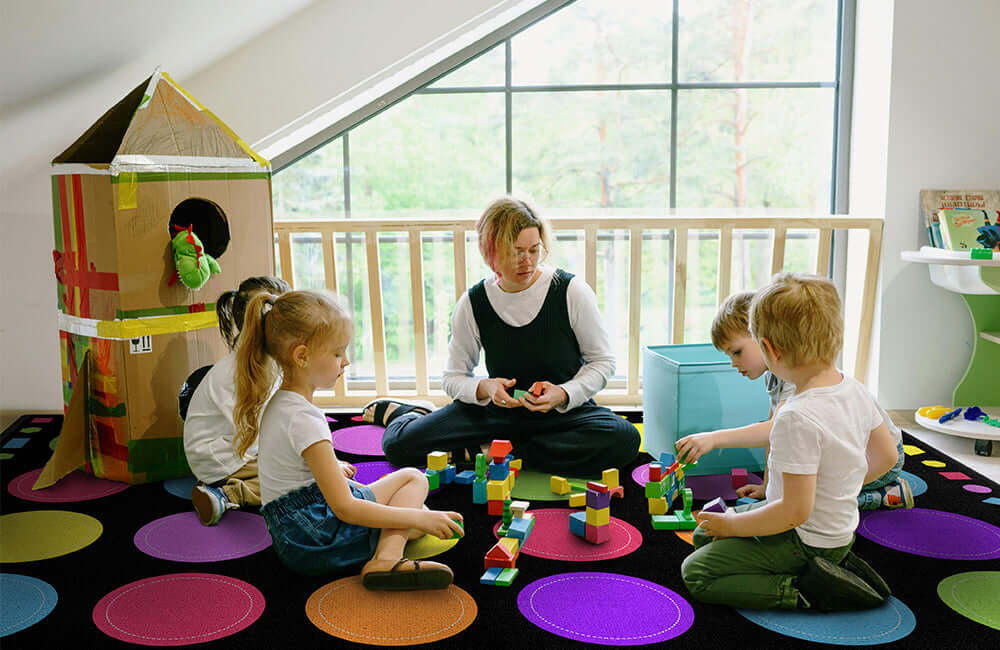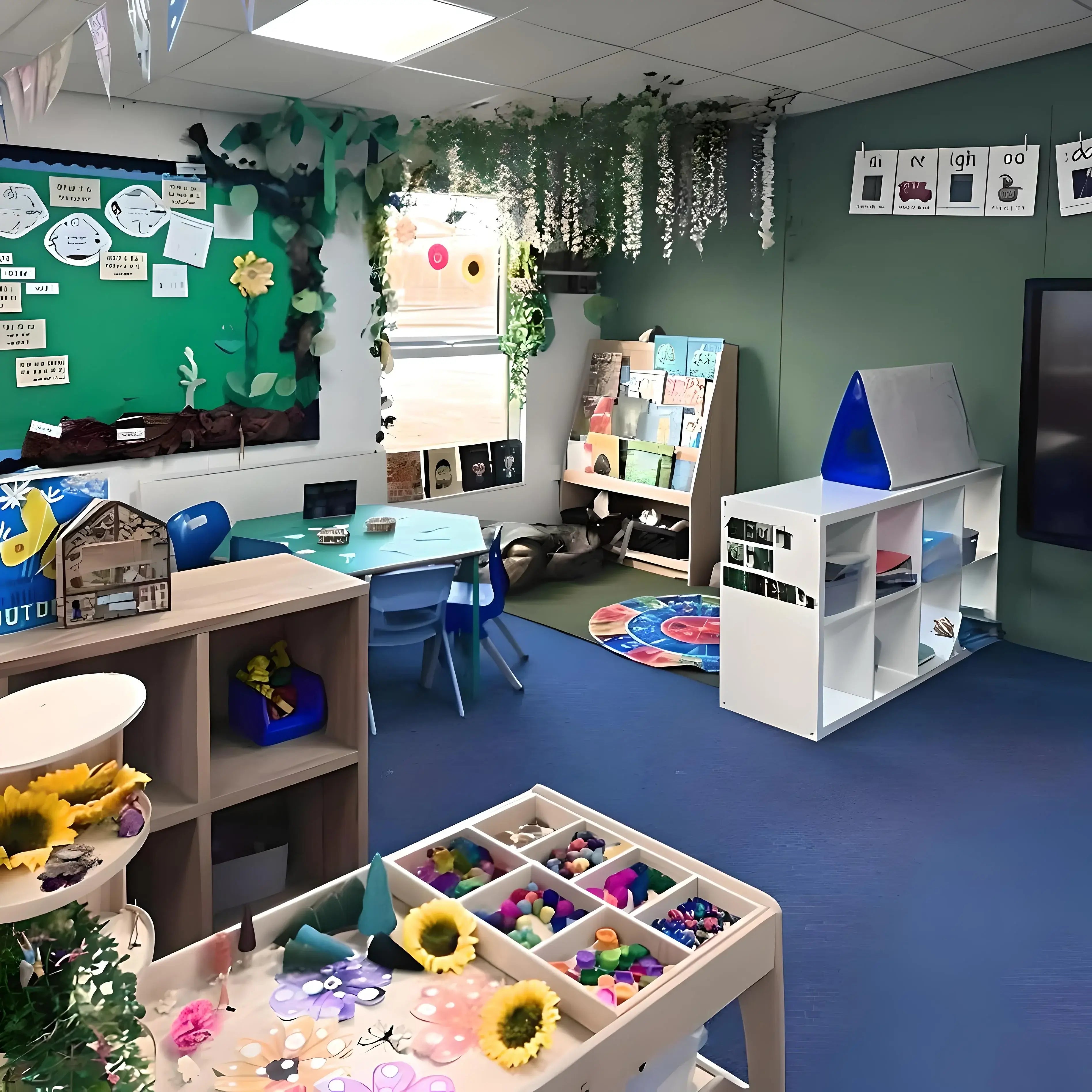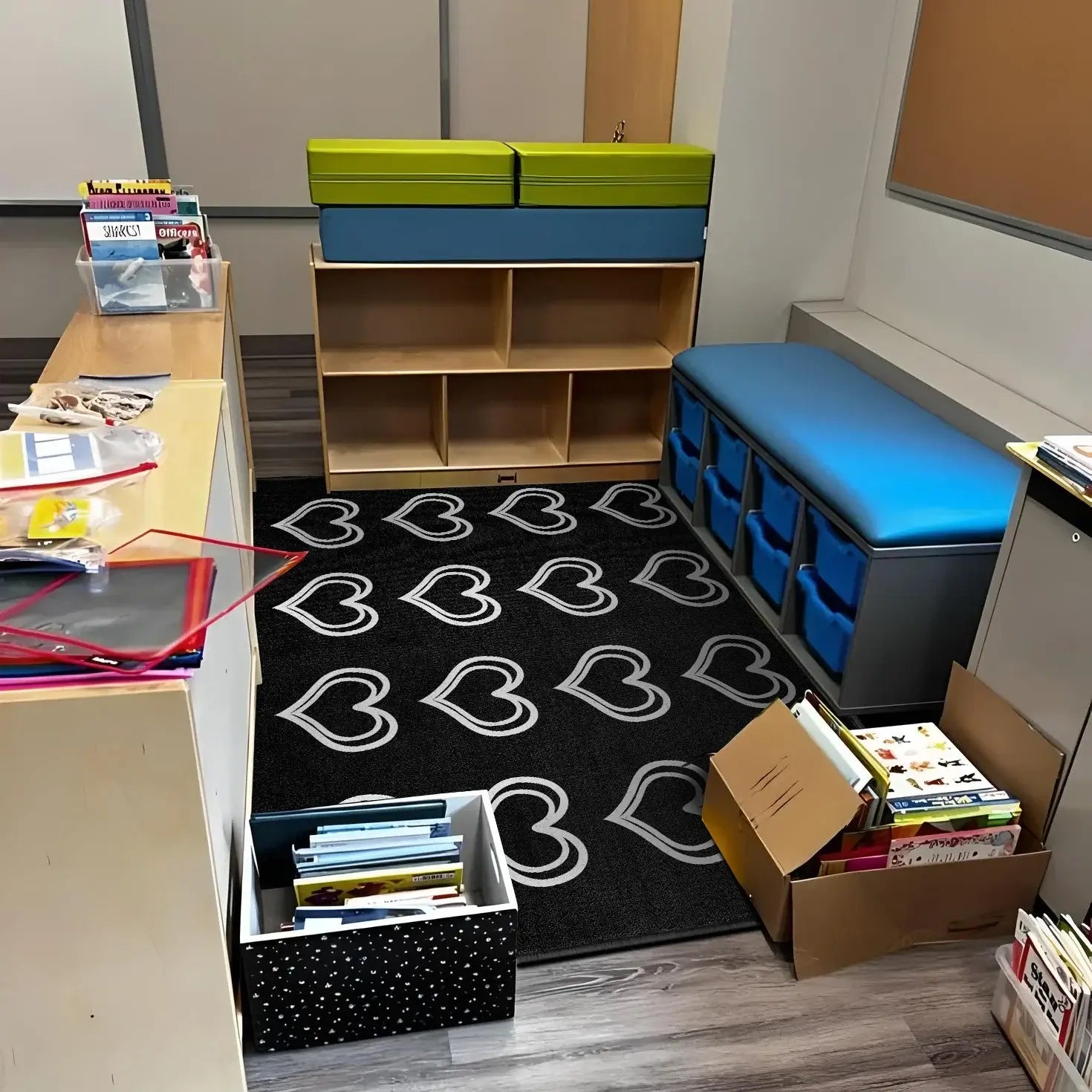The Small Classroom Reality
Modern education often occurs in spaces originally designed for different purposes - converted storage rooms, repurposed offices, or subdivided larger classrooms.
These compact environments demand innovative approaches to space utilization that prioritize functionality without sacrificing student comfort or learning effectiveness.
According to research published in the Journal of Environmental Psychology, classroom density and spatial organization significantly impact student behavior, attention spans, and academic achievement.
Strategic use of classroom rugs helps mitigate the negative effects of cramped conditions while maximizing available space.
Space-Saving Rug Selection Principles
Size Optimization Strategies
In small classrooms rug size becomes critical to overall space functionality.
Rather than filling entire floor areas, strategic placement of appropriately sized rugs creates defined zones while preserving pathways and movement areas essential for classroom flow.
Consider these sizing guidelines for compact spaces:
- Use 4x6 foot rugs for reading corners in tight spaces
- Select 6x8 foot options for multi-purpose gathering areas
- Choose 3x5 foot accent rugs for individual or partner work zones
- Implement runner-style rugs to define pathways and boundaries
Multi-Functional Design Features
Small spaces demand rugs that serve multiple educational purposes simultaneously.
Educational patterns, interactive elements, and organizational features built into rug designs eliminate the need for additional floor space dedicated to separate learning tools.
Look for space-saving features like:
- Alphabet and number borders that support literacy and numeracy
- Built-in seating circles that organize group activities
- Map designs that serve geography and social studies instruction
- Grid patterns that facilitate mathematics and measurement activities
Strategic Placement for Maximum Impact
Creating Zones Without Walls
Classroom rugs act as flexible room dividers that define different learning areas without permanent physical barriers.
This zoning approach allows small spaces to serve multiple functions throughout the day while maintaining visual openness that prevents claustrophobic feelings.
Space-efficient storage solutions Integration
Position rugs to complement vertical storage systems and wall-mounted organizational tools.
The combination of floor-based learning areas with overhead storage maximizes every available dimension in cramped classrooms.
Traffic Flow Optimization
Strategic rug placement guides student movement patterns, reducing congestion and improving classroom management in tight quarters.
Well-positioned floor coverings create natural pathways that enhance safety and accessibility.
Multi-Purpose Rug Applications
Transformable Learning Centers
Small classroom rugs must adapt to changing educational needs throughout the day.
Morning circle time areas become afternoon independent reading spaces, then evening seating rug zones for collaborative learning, maximizing the educational value of limited floor space.
Portable and Flexible Options
Consider lightweight, easily moveable rugs that can be repositioned based on daily activities.
This flexibility allows small classrooms to reconfigure quickly for different subjects, group sizes, and instructional approaches.
Vertical Storage Solutions
When not in use, some rugs can be rolled and stored vertically against walls or in narrow spaces, freeing floor area for alternative activities.
This approach works particularly well with seasonal or subject-specific rug designs.
Maximizing Vertical Space Integration
Wall-to-Floor Learning Continuity
Connect wall displays with floor-based rug activities to create seamless learning environments that utilize both horizontal and vertical space efficiently.
This integration approach makes small rooms feel larger while providing comprehensive educational support.
Ceiling-Mounted Storage Coordination
Coordinate rug placement with overhead storage and display systems to ensure adequate clearance while maximizing the use of typically underutilized ceiling space in small classrooms.
Technology Integration in Confined Spaces
Compact classroom technology Coordination
Modern small classrooms often incorporate tablets, interactive projectors, and other digital tools that require floor space for optimal use.
Strategically placed rugs provide comfortable surfaces for technology-enhanced activities without crowding limited space.
Cable Management and Safety
Rugs in small spaces must accommodate technology cables and power cords safely.
Choose options with appropriate thickness and edge treatments that prevent tripping hazards while maintaining aesthetic appeal.
Color Psychology for Small Spaces
Light and Bright Strategies
Light-colored rugs reflect available light and create illusions of spaciousness in cramped classrooms. Avoid dark colors that absorb light and make small spaces feel even more confined.
Pattern Selection for Visual Expansion
Certain patterns can make small rooms appear larger through visual tricks and optical illusions. Diagonal designs, subtle textures, and geometric patterns often work better than busy prints in confined spaces.
Student Comfort in Cramped Conditions
Personal Space Considerations
Small classrooms make personal space management critical for student comfort and behavior. Well-designed rug areas provide defined boundaries that help students feel secure despite close proximity to peers.
Sensory Regulation Support
Crowded conditions can overwhelm students with sensory processing sensitivities. Carefully selected rug textures and placement provide calming influences that help regulate sensory input in stimulating environments.
Maintenance and Hygiene in Small Spaces
Cleaning Access and Efficiency
Small classroom rugs require easy maintenance procedures that don't disrupt limited space functionality. Choose options that accommodate quick cleaning methods and don't require extensive drying times that would interrupt classroom use.
Air Quality and Ventilation
Proper rug selection becomes more critical in small, potentially poorly ventilated spaces. Low-emission materials and antimicrobial treatments help maintain healthy air quality in confined learning environments.
Creative Storage Integration
Under-Rug Storage Solutions
Some small classroom designs benefit from raised rug systems that create hidden storage underneath. This approach maximizes floor utility while providing discrete organization options for classroom supplies.
Modular and Stackable Options
Consider rug systems that can be stacked or nested when not in use, similar to puzzle pieces or interlocking tiles. These innovative solutions provide maximum flexibility in space-constrained environments.
Budget Considerations for Small Spaces
Cost-Per-Square-Foot Analysis
Small classroom rugs often offer better value per educational impact than larger options, making them budget-friendly choices for schools with financial constraints.
Calculate the educational return on investment based on multiple daily uses rather than size alone.
Shared Resource Strategies
Small schools or departments can share specialized rugs between classrooms, rotating them based on curriculum needs. This approach provides variety while reducing individual classroom costs.
Small classroom layout Planning
Measuring and Mapping
Accurate measurements and careful planning prevent costly mistakes when selecting rugs for small spaces. Create scale drawings that include furniture, doorways, and traffic patterns before making purchasing decisions.
Flexibility for Future Changes
Choose rug solutions that can adapt to potential classroom reconfigurations or changing educational needs. Flexibility becomes even more valuable in small spaces where options are limited.
Addressing Common Small Space Challenges
Noise Control and Acoustics
Small classrooms amplify sound, making noise control essential for learning effectiveness. Rugs provide acoustic dampening that reduces echo and background noise in hard-surfaced, compact environments.
Lighting and Visual Appeal
Limited natural light in small spaces requires careful attention to rug colors and patterns that enhance rather than diminish available illumination. Strategic selection can dramatically improve the visual appeal of cramped quarters.
Success Stories and Case Studies
Urban School Solutions
Many urban schools face severe space constraints but have successfully implemented creative rug solutions that maximize learning potential. These real-world examples provide inspiration and practical guidance for similar situations.
Temporary and Portable Classrooms
Mobile and temporary classroom environments present unique space challenges that innovative rug applications can address effectively. These solutions often transfer to traditional small classroom settings.
Future Trends in Small Space Education
Micro-Learning Environments
Educational trends toward personalized, small-group instruction make compact classroom design increasingly relevant. Rug-based solutions provide foundations for these emerging pedagogical approaches.
Sustainable and Eco-Friendly Options
Environmental consciousness drives demand for sustainable rug options that don't compromise functionality in small spaces. These choices often provide additional benefits like improved air quality and reduced environmental impact.
Conclusion
Maximizing small classroom spaces requires strategic thinking, creative problem-solving, and careful attention to multi-functional design elements.
Classroom rugs, when thoughtfully selected and positioned, transform cramped quarters into efficient, comfortable learning environments that support student success despite spatial limitations.
The key to success lies in viewing space constraints as design challenges rather than insurmountable obstacles.
By prioritizing flexibility, functionality, and student comfort, educators can create small classroom environments that rival larger spaces in educational effectiveness and student satisfaction.
Small doesn't have to mean limited when smart design principles guide classroom rug selection and placement.
With careful planning and creative implementation, even the tiniest learning spaces can become dynamic, engaging environments where students thrive and teachers succeed.




Leave a comment
This site is protected by hCaptcha and the hCaptcha Privacy Policy and Terms of Service apply.